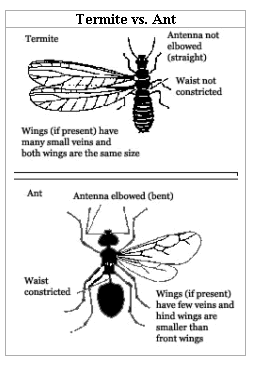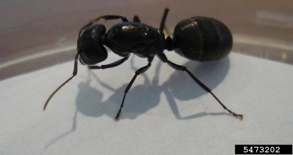Termites
The most important and costly structural insect pest in Connecticut is the eastern subterranean termite. They range from 1/4 to 3/8 of an inch in length. The cream-colored workers are wingless and usually enter structures through wood that is in direct contact with the soil.
To help prevent termite problems, such direct contact of wood with soil should be eliminated. In some cases, termites may build mud tubes across surfaces such as concrete to allow them to reach the wood from the soil. The workers are very susceptible to desiccation. By moving through mud tubes they remain in contact with high humidity from the soil and avoid the drying effects of sunlight and air currents. If the tan mud tubes are found, they should be broken and the adjacent wood should be examined for termite damage.
The presence of winged reproductives, or swarmers, in a building is a good indicator that a colony of at least five years of age is present. Swarmers are black and are most frequently mistaken for "flying ants." Swarming generally occurs during early spring.
The differences between termites and ants are shown in the diagram below. Note that termites do not have the narrow or constricted waist that ants possess. Termites also have straight rather than "elbowed" antennae.

Prevention of termite infestation is critical to managing this pest. Termites must have access to moist soil. Divert rainwater away from the foundation of the structure with gutters, downspouts and splash blocks. Keep the soil graded away from the foundation so that surface water will drain away from the building. Any wood that is in direct contact with the soil gives termites easy, unobserved access to the structure. Never store wood or wood products (firewood, lumber or newspaper) next to the foundation or in the crawl space. Do not bury wood scraps when back filling foundation during construction. Keep wood mulch at least 12 inches away from the foundation. Use pea stone next to the foundation to keep the area warmer and drier.
Finding termites in a structure does not constitute an immediate emergency because the rate at which damage occurs is relatively slow We strongly recommend hiring a licensed professional exterminator when termite control is needed. Consider getting at least three estimates before signing a contract with a pest control company. Be cautious of much higher or much lower prices. Pricing for treatment, inspections and warranties vary widely. Take your time when selecting a licensed, certified pest control company that has been doing business in your area for some time with a good professional reputation. Your local building official may be helpful in finding a company with a good reputation. Always check with your local better business bureau or consumer protection before hiring a termite control firm.
Carpenter Ants
These are the largest of our local ants and may excavate areas of moist wood for nests. The damage caused is much less severe than that of termites. Carpenter ants may be all black or may also have a reddish-brown area in the middle of their bodies. Workers are 1/4 to 1/2 an inch in length. The winged reproducers or swarmers are 1/2 to 3/4 of an inch in length, and their presence indicates a colony that is at least three years old.

The mere presence of these ants does not always mean that they are living or nesting in the house. If only a few ants are seen, they are probably only foragers from the outdoors. Workers can forage hundreds of feet from a colony in search of food. Larger numbers found daily, unexplained small piles of sawdust or ants active during the winter are good indications that the building may contain a nest. Ants (unlike termites) do not eat the wood but excavate it for a nest. Carpenter ants may also live in wall void areas without affecting the wood.
Moist areas with damp wood, however, are often preferred sites of infestation. Such areas may include wood moistened by leaking or sweating pipes in kitchen sink and bathroom areas. Other suspect areas may include leaky roofs and "punky" wood on decks, doors or windows. Such moisture-related problems should be repaired and deteriorating wood replaced.
To achieve effective carpenter ant control, any nests in the building must be found and eliminated. To help locate nests indoors, use "crack and crevice" ant and roach sprays directed into suspect areas. If the spray reaches a nest, ant activity will increase, and ants may appear, alerting you to the nesting area. Once the nest is found and exposed, the ants may be controlled with an ant and roach aerosol spray mist. Applying a spray treatment to the outside foundation may reduce foragers from the outside. If all efforts to control carpenter ants fail, a licensed professional may be required.
Despite good cultural practices, pests and diseases at times may appear. Chemical control should be used only after all other methods have failed.
For pesticide information or other questions please call toll free: 877-486-6271.
Revised by UConn Home and Garden Education Center 2016.